-
Car Reviews
- All reviews
- Midsize SUVs
- Small cars
- Utes
- Small SUVs
- Large SUVs
- Large cars
- Sports SUVs
- Sports cars
- Vans
Latest reviews
- Car News
-
Car Comparisons
Latest comparisons
- Chasing Deals
Arguably the most important variant of the new range, the all-new Kona Electric has hit Aussie shores – but is it worth the price premium over the Hybrid?
It’s a sign of the times: Hyundai is no longer an entry-level brand.
In an age when cut-price Chinese carmakers such as MG and BYD are offering electric cars at sub-$40K prices, the new Kona Electric has its work cut out for it.
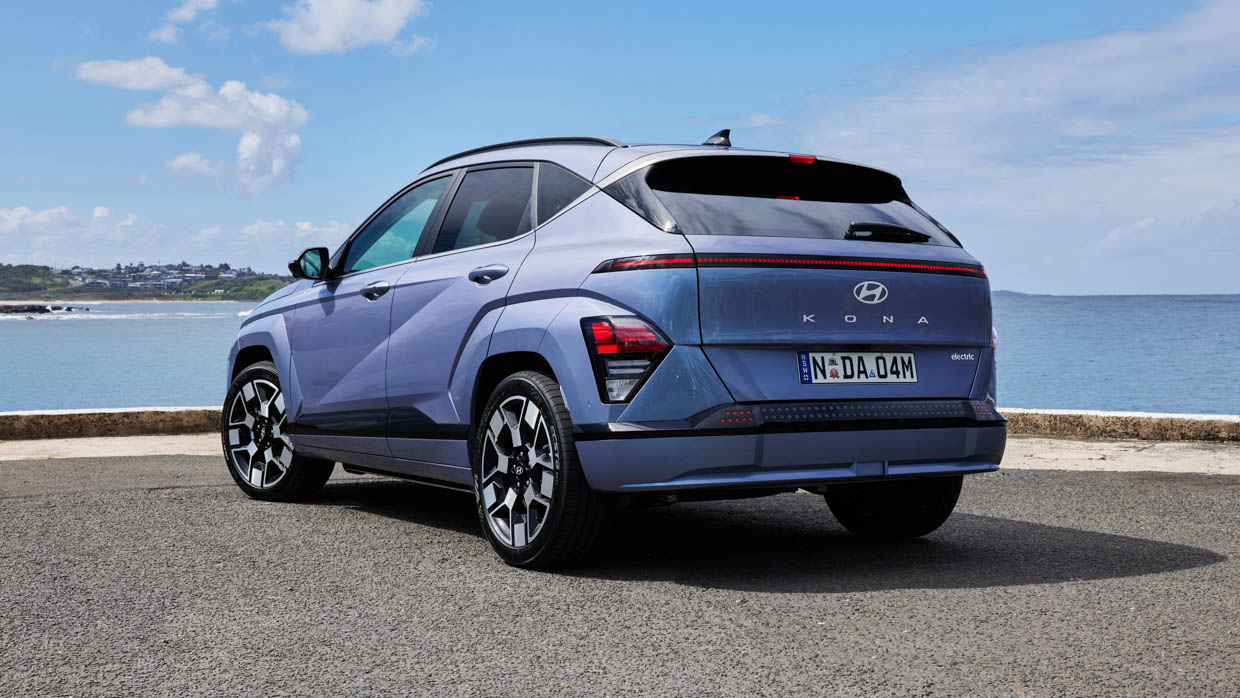
And testament to how important this small electric SUV is for the Korean brand, Hyundai says the second-generation model was designed as an EV first and foremost, before then being reconfigured for its internal combustion-powered variants.
However, despite being designed first, it’s also the last powertrain variant to launch in Australia behind its petrol– and hybrid-powered Kona siblings, the latter of which Hyundai expects to make up the bulk of the model’s sales locally.
While that’s to be expected – and while the previous Kona Electric made up around 10 percent of sales – the new Kona Electric is a crucial vehicle for Hyundai to get right.
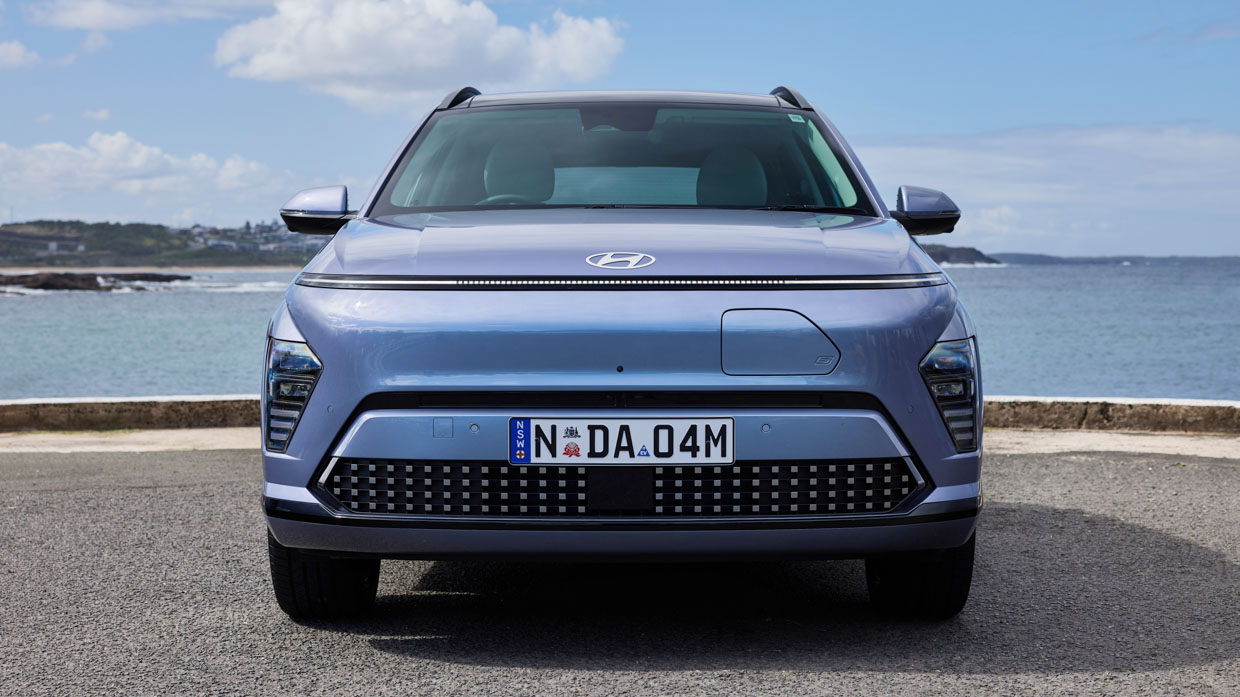
Marking the entry-point into electric Hyundai ownership below the more expensive Ioniq models, it’s the Kona that will be doing the heavy lifting against the likes of the MG4 and BYD Atto 3.
With both of those vehicles available at sub-$40K and sub-$50K prices respectively, it becomes clear how challenging the Kona Electric must have been for Hyundai to price, especially in context of the ICE-powered Kona variants having gone up in price by close to 20 percent for the new generation.
A similar price increase likely wouldn’t have passed muster for the electric, and the bigger and better new generation has actually come in $500 cheaper than its predecessor for the entry-level Kona Electric priced at $54,000 before on-road costs. However, that’s not the case the further up the range you go, as we will discover.
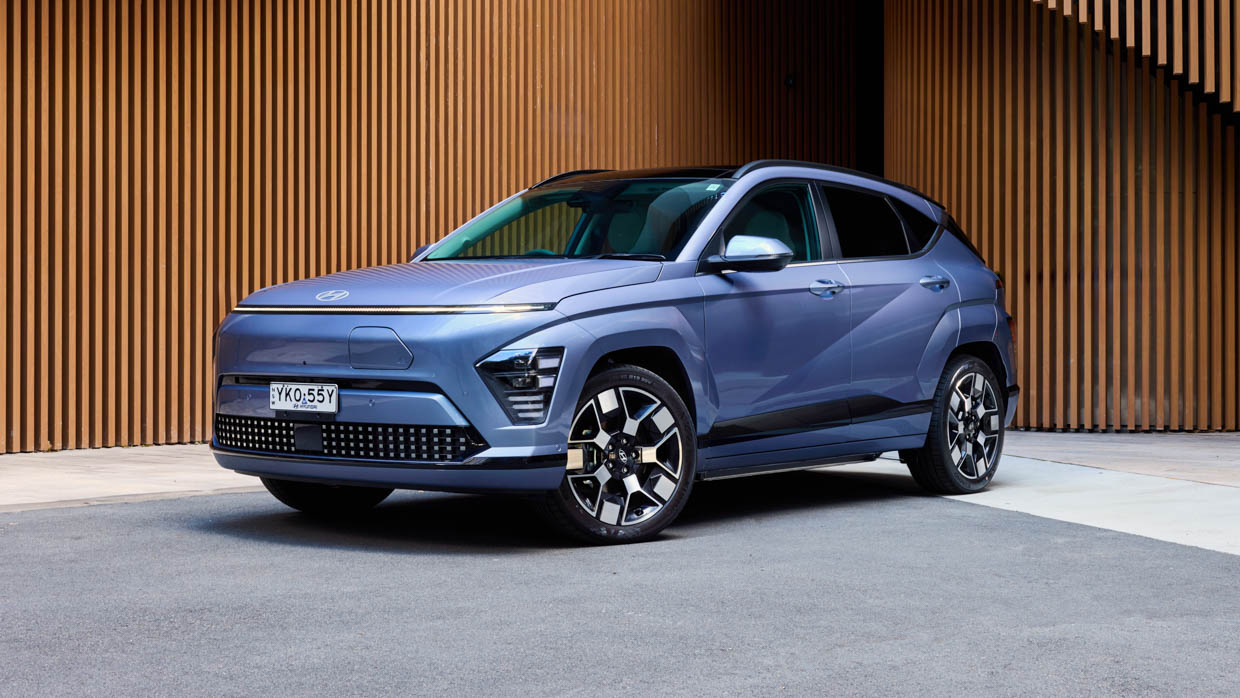
So, how does the Kona Electric stack up in this brave new world of electrification? It was designed as an EV first after all, so can we expect it to be the best Kona to drive? And does it make a strong enough case for itself when the range now also includes a compelling – and more affordable – hybrid option for the first time?
The Kona Electric is available in two trims – the entry-level grade simply named ‘Kona Electric’, or the Premium, which we have on test with us today, with assessment conducted at the model’s Australian launch.
Within the entry-level variant you can spec it with either standard or extended range, the latter of which is the only spec offered for the Premium.
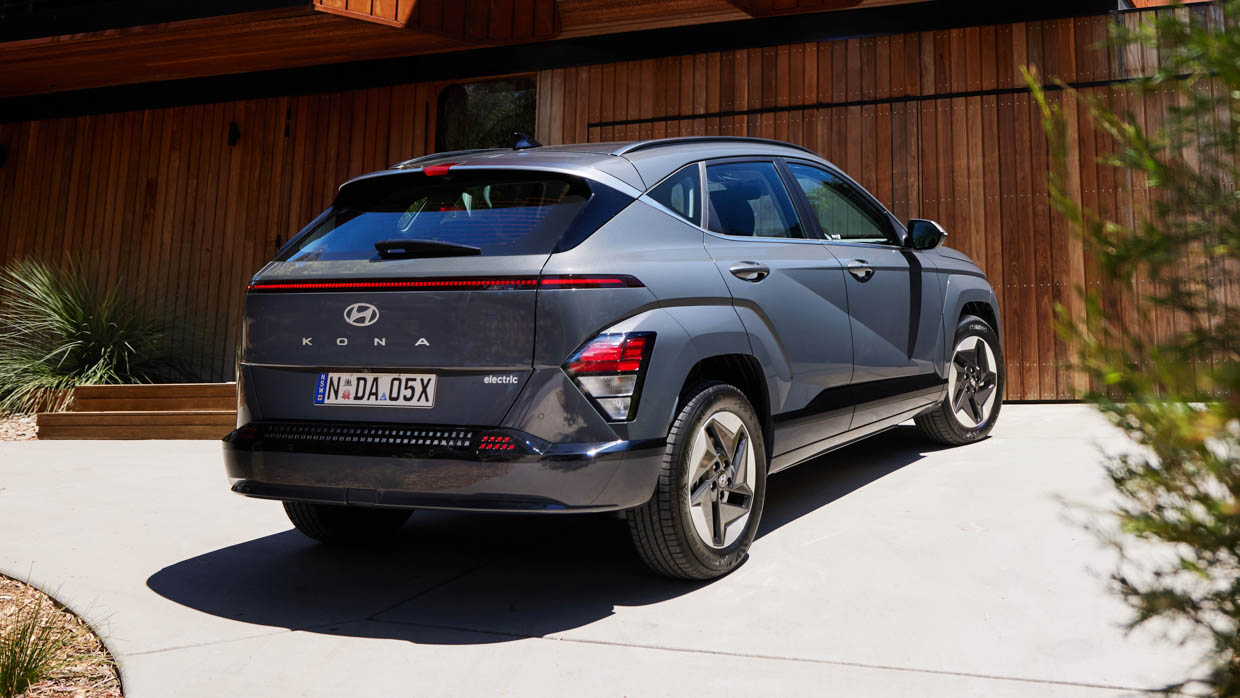
Pictured: the entry-level Kona Electric
While the Kona Electric standard range comes in at $54,000, the extended range charges an additional $4000 on top of that at $58,000, with the range-topping Premium coming in at $68,000, all prices before on-road costs.
Unlike the entry-level model, which is slightly cheaper than the previous generation, and the mid-spec extended range, which is $2,500 cheaper than its predecessor, the top-spec Premium asks $4,000 more than the previous generation’s range-topping Highlander Extended Range variant.
So, what do you get for the price?
The standard range features a 48.6kWh battery delivering 99kW/255Nm as well as a claimed range of 370km (WLTP). Meanwhile, the extended range features a 64.8kWh battery delivering 150kW/255Nm.
Both battery capacity figures are gross, and it’s unclear what the usable capacities are.
Importantly, the claimed WLTP range is different for the extended range depending on whether you go for the entry level or the Premium.
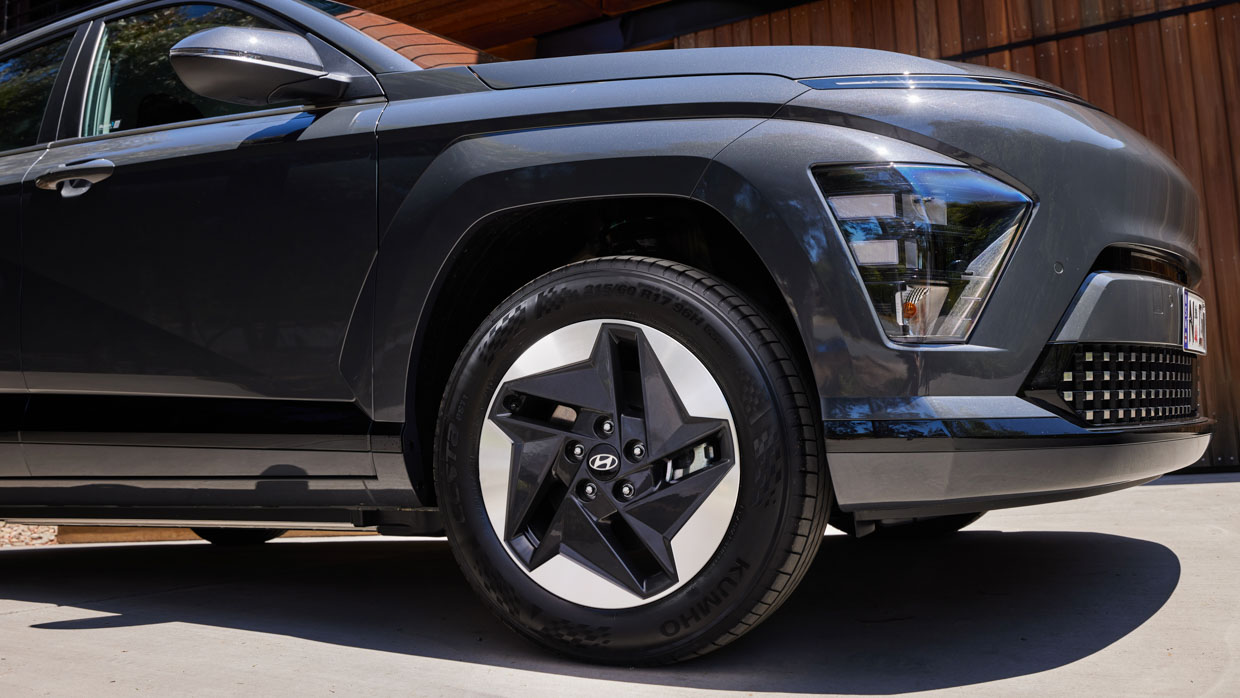
Pictured: the entry-level Kona Electric
The base spec rides on smaller 17-inch wheels and delivers a claimed range of 505km, while the Premium – which rides on bigger and heavier 19-inch wheels, and loads in more features – delivers a range claim of 444km.
So if range is a key consideration, and you can afford to go without the fruit of the Premium, the extended-range entry-level Kona Electric may be the way to go.
All variants are front-wheel-drive only and powered by the same permanent magnet synchronous motor. The only all-wheel-drive Konas you can buy are the N-Line turbo-petrol variants.
We look forward to doing a full real-world range and consumption test in the Kona Electric, however for now Hyundai claims figures of 14.8kWh/100km for the standard-range Kona Electric, 14.7kWh/100km for the extended-range Kona Electric, and 16.7kWh/100km for the Kona Electric Premium.
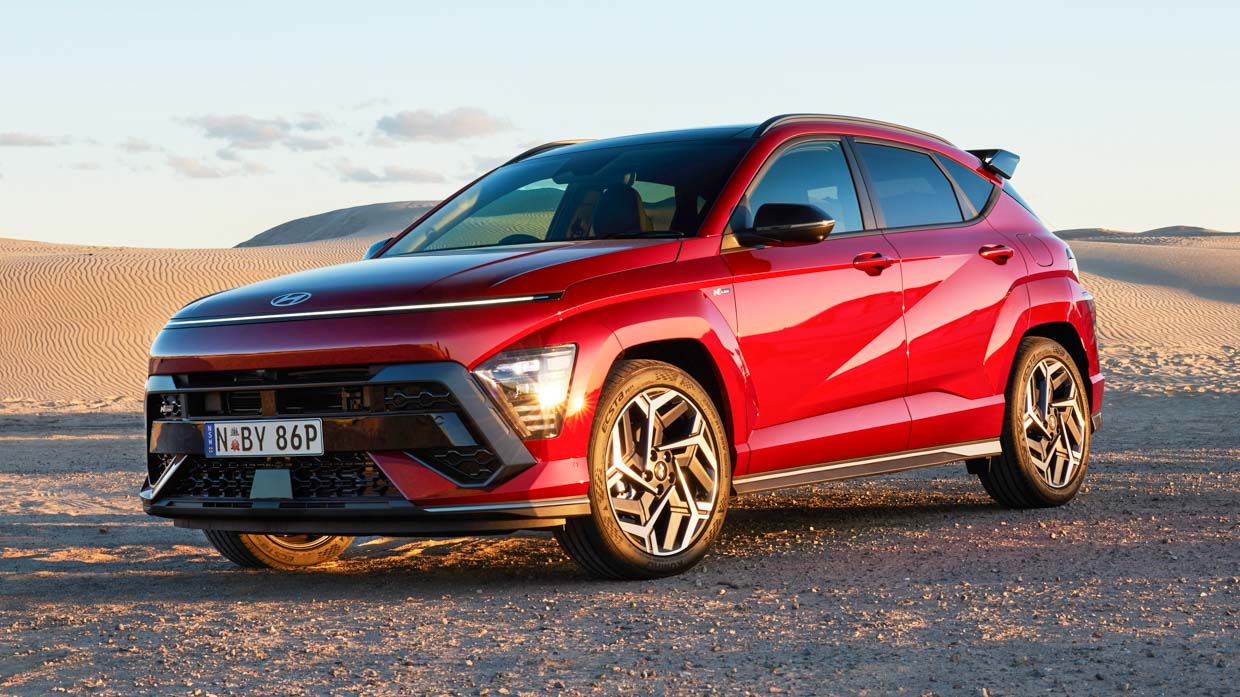
Pictured: the sporty, petrol-powered N-Line variant
Hyundai also claims that it will take you 45 minutes of fast charging to get from 10 percent to 80 percent charging using a 100kW DC charger in optimal conditions. That’s for both the 48.6kWh and 64.8kWh batteries.
It might not be the pinnacle in terms of range compared to its cheaper entry-level extended-range counterpart, but in every other respect the Kona Electric Premium is the pinnacle of the Kona in Australia. It’s the most expensive variant you can possibly buy and comes jam-packed with all of the fruit. So, what do you get for jumping up to the Premium?
Firstly, in terms of styling – surprise, it looks very similar to the rest of the Kona range. That could be a good or bad or completely inconsequential thing depending on how you look at it.
Overall this reviewer is a fan of the new Kona’s styling but that’s completely subjective, and there are also a few key differentiators which will make it easy for you to spot the difference between the Electric on the road as compared to its petrol family members.
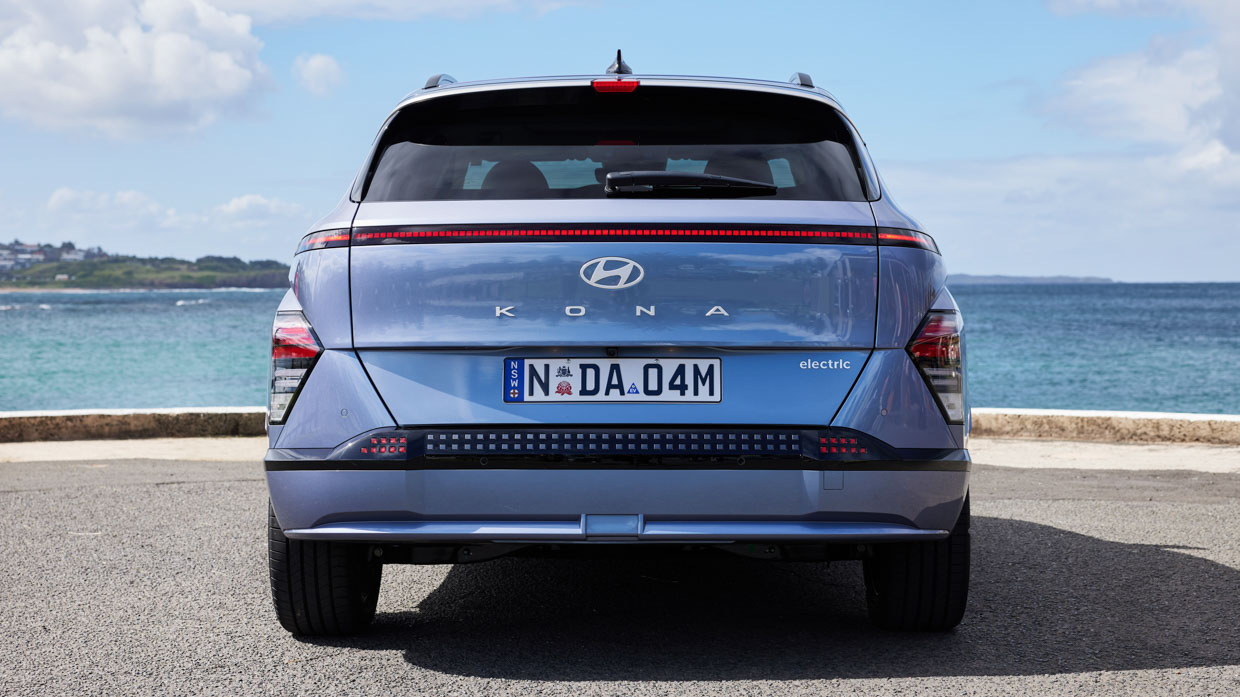
Pixels! There are lots of them, and the Electric Premium sports a ‘pixelated seamless horizon light’ – as Hyundai calls it – stretching along the length of the Robocop-style face of the Kona. There’s also a pixel-pointed lower intake garnish and the tail lights also continue the pixel theme on the back, a nice nod to the Ioniq electric range.
The Electric gains a gloss black lower body moulding along the side, and like the N-Line, also includes body-coloured wheel arches instead of the grey plastic cladding that features on other models.
As mentioned earlier, you get larger wheels with the Premium, but regardless of that all wheel-designs are EV-specific.
And of course, the dead giveaway you’re in the Electric is the charging connection located on the front face just under the bonnet.
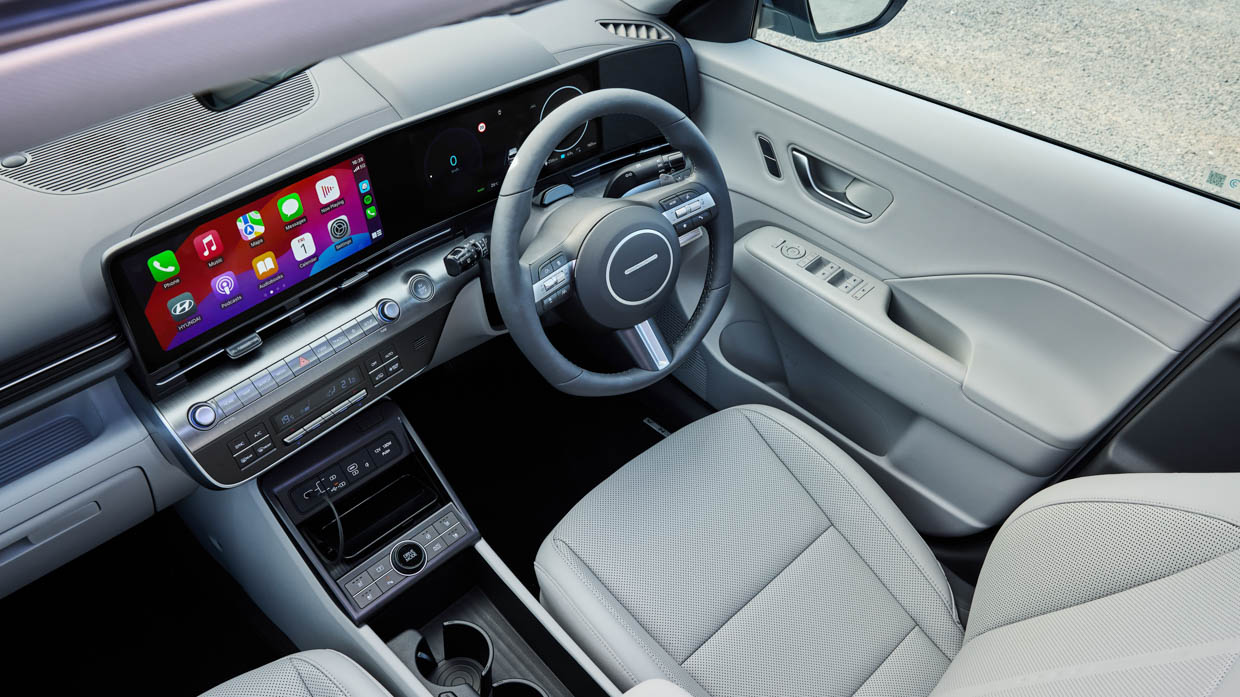
The Kona Electric already comes with a host of standard features in its entry-level grade, with some highlights detailed below:
As well as this, there are a suite of standard safety features, which we will detail when we get into the Kona’s safety.
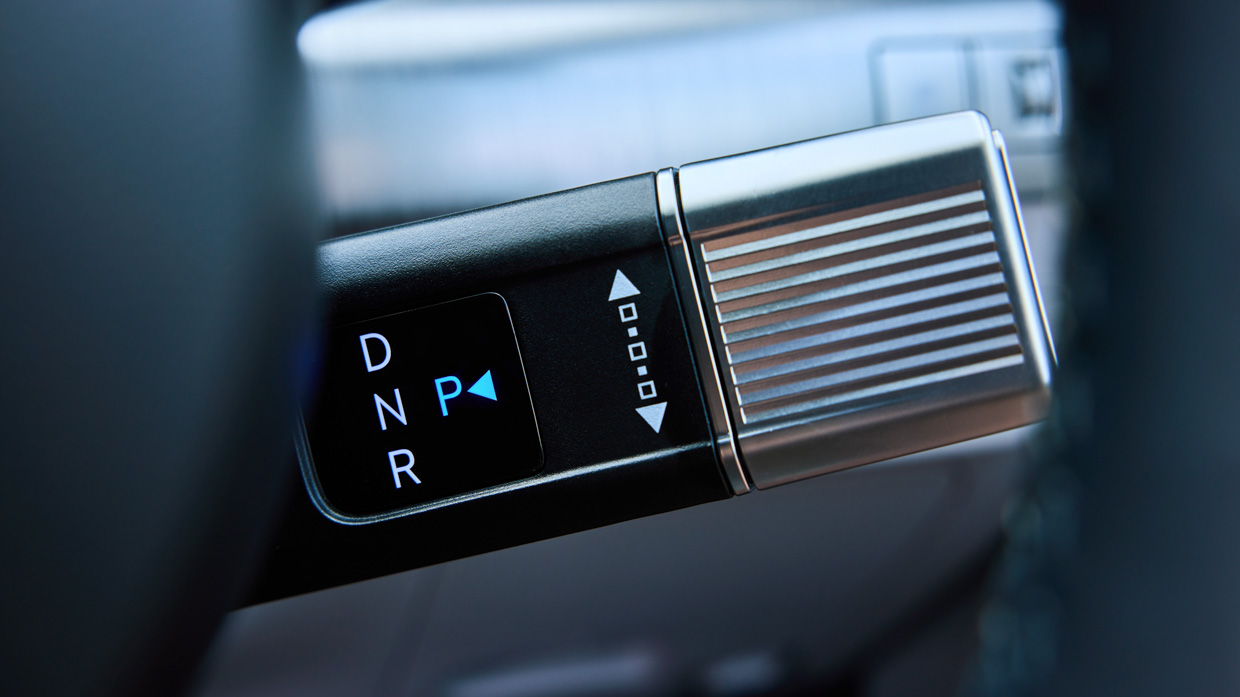
So what do you gain from stepping up to the Premium? The more expensive variant gains features like:
With the Kona electric acting as the entry vehicle into Hyundai’s electric range, there’s a chance it might be your first time considering an EV, or perhaps you might be contemplating stepping up from the petrol Kona variants.
If that’s the case, then you’ll find there’s a lot going for the Electric, at least that’s what we found on our first initial drive.
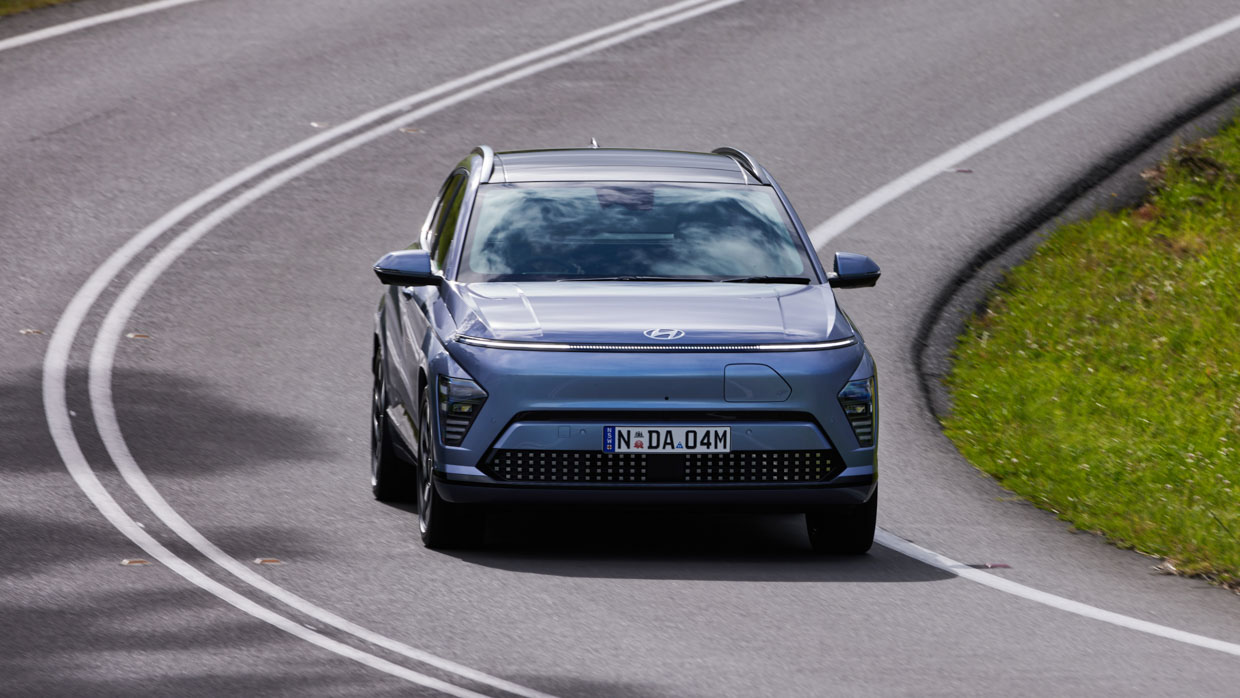
If you’re someone who hasn’t driven many electric vehicles you should find that the Kona Electric feels extremely natural to drive. What’s more, if you’re coming from the petrol, there’ll be some obvious advantages in terms of the refinement and power delivery with the Kona Electric taking many of the good traits of the regular Kona and stepping them up a notch.
Given there’s no petrol engine, it’s quieter, and it’s also more naturally effortless in driving style with smooth and instantaneous acceleration. There’s no lag and no waiting for a gearbox to shift in response to your throttle input.
With that regard, the 255Nm new Kona Electric actually has a significantly lower torque figure compared to the previous generation’s 395Nm, a deliberate decision by Hyundai to deliver more usable, and everyday driveability.
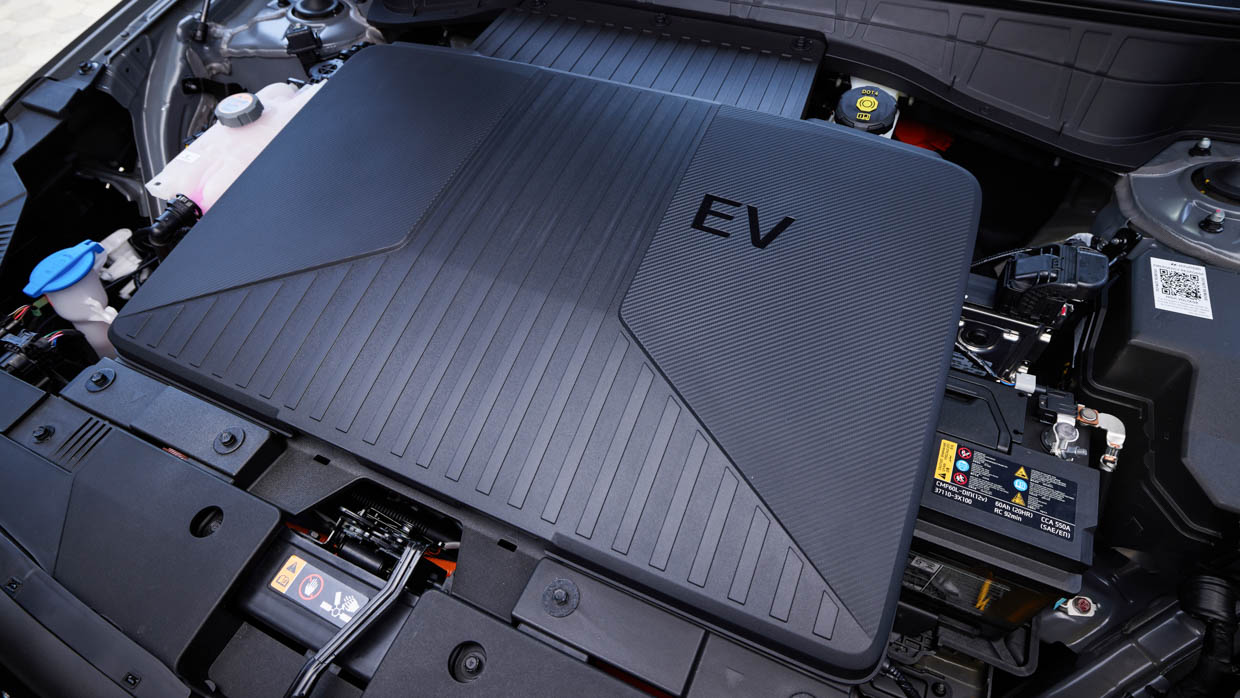
And that certainly seems to be the case. The power delivery is progressive, linear, and easy to modulate. At 150kW, it’s not a crazy amount of power, but there’s plenty there and enough for you to get going at a very brisk pace.
We haven’t yet tested 0-100km/h times but we look forward to sharing them with you when we do.
So in that sense, it’s so far so good for the Kona Electric – it all feels rather normal, in a good way. But what else is different?
Well, for starters, there’s the iPedal and regenerative braking. If you haven’t driven an EV, then this common electric car feature essentially allows for one-pedal driving: that is, you can effectively use only the accelerator to power and stop the car, with the car slowing whenever you remove input from the accelerator.
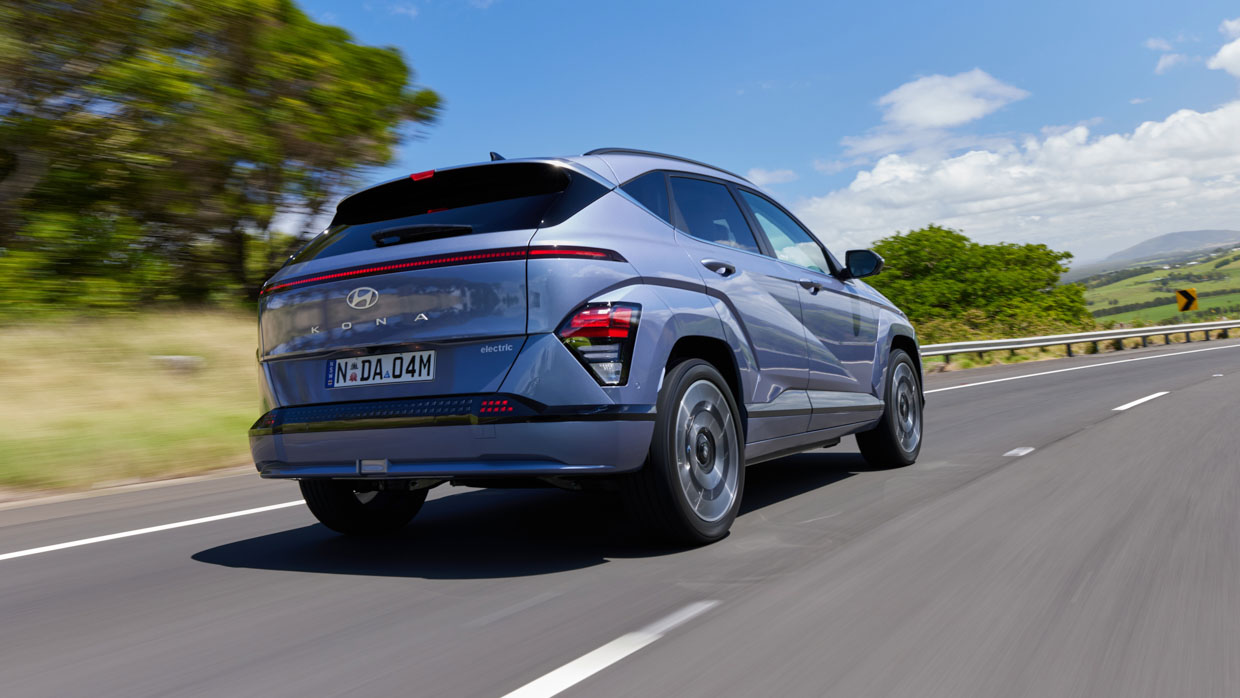
Personally, this reviewer enjoyed the feature given that it allowed for an extra level of engagement to the drive experience, and an extra element to master. But, if it’s not your cup of tea, you can easily revert back to a traditional two-pedal experience as per a normal petrol car.
Aside from the iPedal, the Kona Electric also features a smart regenerative braking system, which can automatically adjust the level of regenerative braking applied based on the incline of the road and behaviour of the vehicle ahead. Or, you can take control and adjust it in three variable stages by using the steering wheel-mounted paddle-shifters.
This added tailorability is appreciated. Switching between options is easy, too. You can engage maximum regeneration by holding the left paddle, or switch to the automatic mode by holding the right paddle.
Furthermore, you can also bring about a complete stop to the car without using the brake pedal by simply pulling and holding the minus paddle for more than point four of a second.
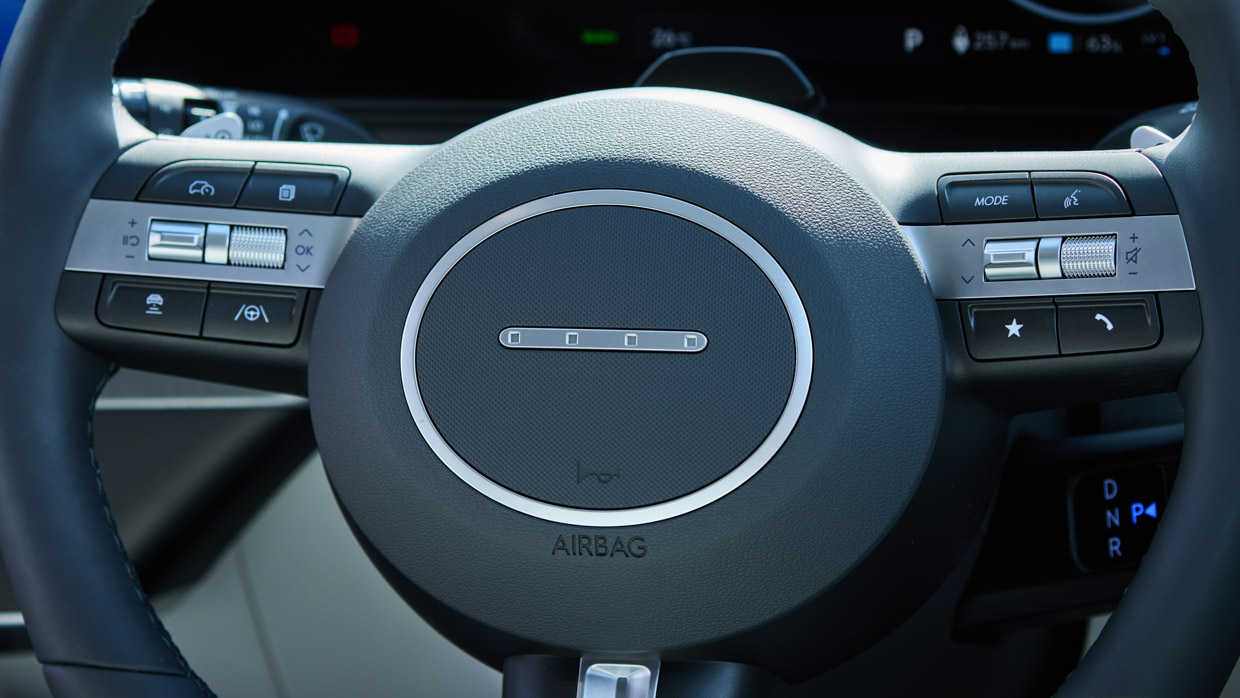
When used conventionally, the brakes are easy to modulate and feel quite good under foot. We haven’t brake tested the Kona Electric, but the Hybrid Premium we drove recently delivered a strong result of 33.83 metres for the 100km/h to zero brake test.
It will be interesting to see how the EV compares given it weighs almost 300kg more than the hybrid in Premium spec.
Notably for an EV, Hyundai says that the extended-range variants are capable of towing, with Hyundai quoting a fairly limited 750kg braked towing capacity. That compares to 1300kg for the petrol and hybrid.
There are four drive modes to choose from including eco, normal, sport and snow, with sport mode making things a bit sharper in terms of responsiveness.
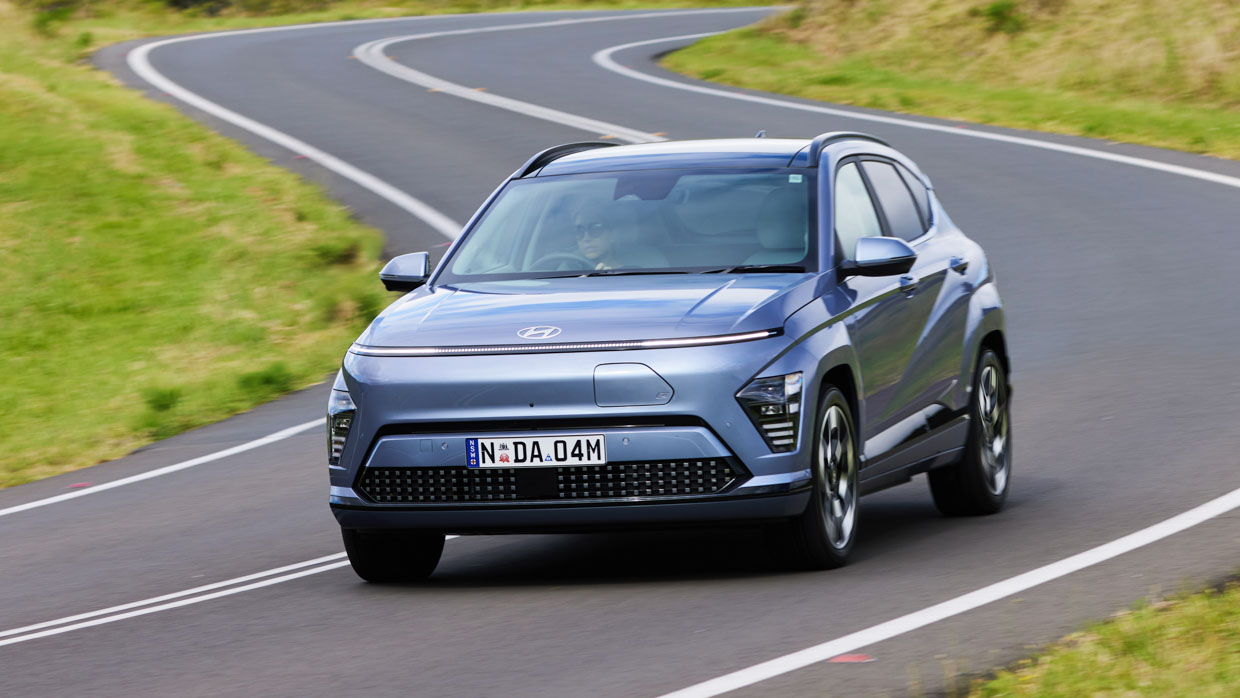
As for steering, it’s light and pleasant to use, making for a nimble and direct car to place on the road.
The ride and handling balance is also quite good on first impression. I got the sense that you could feel the heavier weight of the EV a bit more when punting it through the corners compared to the hybrid I had driven earlier during the launch program, however overall it seemed to handle more than well enough for its intended purpose as an urban focused SUV.
The ride quality is also sound, a well-sorted balance between being firm enough to feel planted on the road but also compliant enough to deliver a quality and comfortable drive experience.
This said, I’d appreciate a longer drive in both entry-grade and Premium variants to ascertain whether the difference in 17- versus 19-inch wheels makes for a noticeable difference in ride quality.
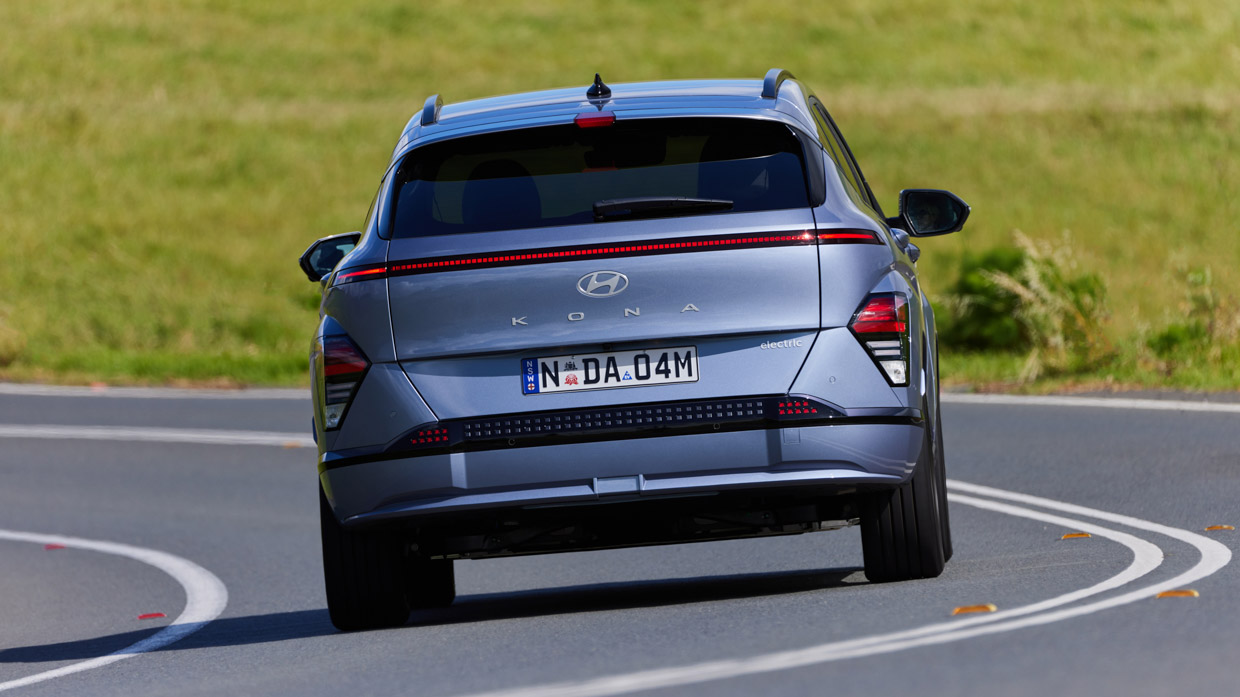
The Kona Electric’s nicely resolved ride and handling balance is surely due to the fact that, like the turbo and hybrid variants, the EV also sits on multilink rear suspension setup, which isn’t offered in the naturally aspirated 2.0-litre variants.
Overall, like the Hybrid, it’s a car that seems at its best when it’s driven in a calm and relaxed manner – that’s when its practical, comfort-focused, and pragmatic personality seems to shine best.
However, in a case of déjà vu or perhaps Groundhog Day if you’ve read our other second-generation Kona reviews, what does interfere with the otherwise pleasant drive experience are the over-zealous active safety features.
Those same criticisms from our previous reviews hold water in the Kona Electric, with the two most-zealous culprits being the speed limit assist and driver attention warning systems, which both ping drivers frequently.
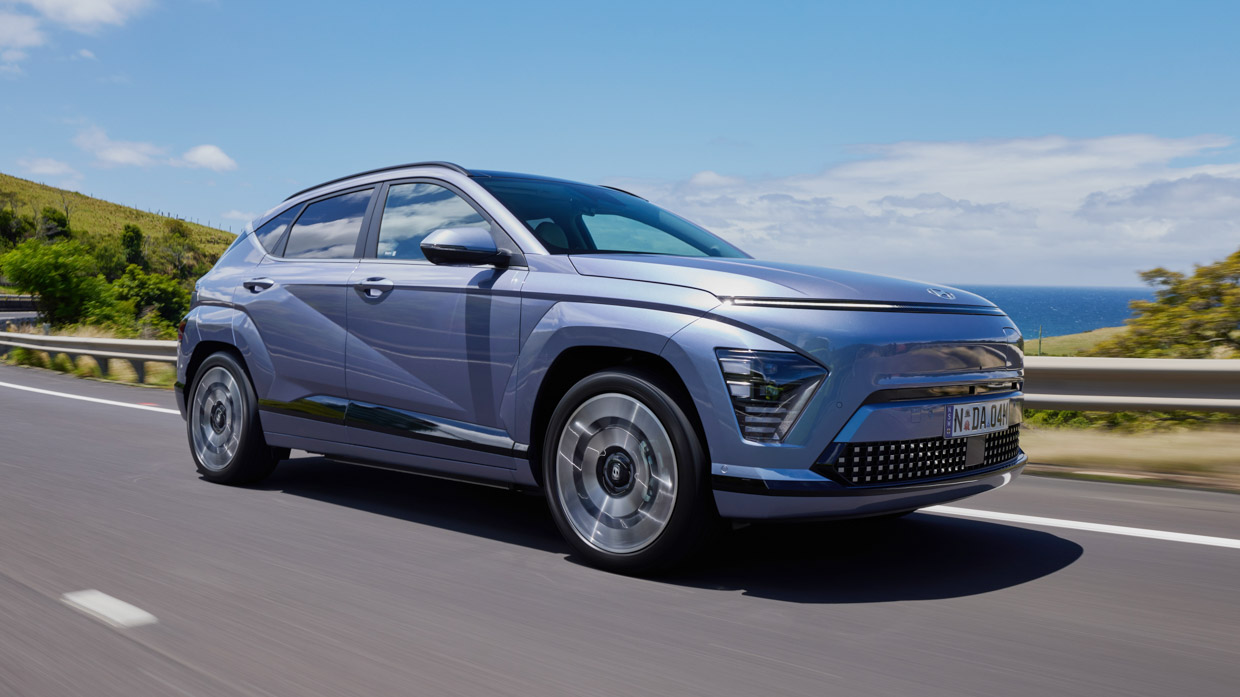
As we have previously noted, the speed limit assist will sound at just one km/h over the posted speed limit, even if the vehicle gets the speed limit wrong.
To avoid it, you’ll need to keep your eyes on the speedo even more, which ironically will set off the driver attention warning which in turn sounds when the camera in front of you notices you aren’t keeping your eyes on the road as much as it thinks you should.
As we mentioned in the Hybrid review, these features can be turned off through multiple steps in the menu – or you can set up a shortcut to switch them off – but they do default to ‘on’ every time the vehicle restarts.
Like the exterior, the interior of the Electric feels very much like the rest of the Kona range – because it essentially is, and that’s not a bad thing by any means.
Overall it’s a pleasant and contemporary cabin to be in. The seats are supportive, with good levels of adjustment and it was easy for me to find a comfortable driving position.
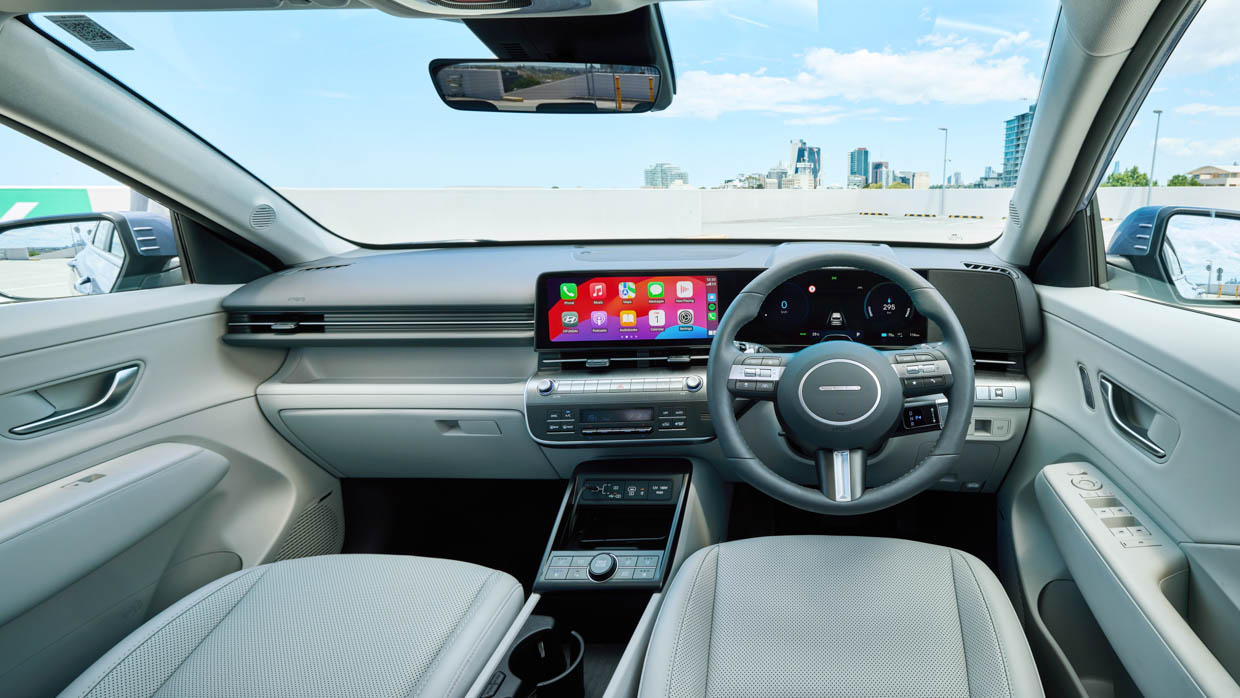
This is helped in the Premium which brings with it a 10-way power adjustment front seat for the driver, with eight-way power adjustment for the front passenger.
While a positive experience overall, it’s not perfect. You do get the same scratchy plastics on the door tops and bottoms that you get across the range, but it does feel solidly screwed together.
The customisation afforded by stepping up to the Premium is also appreciated with the light shale grey trim on test having the double effect of being both pleasing on the eye and also creating a lightness and sense of airiness within the specious cabin.
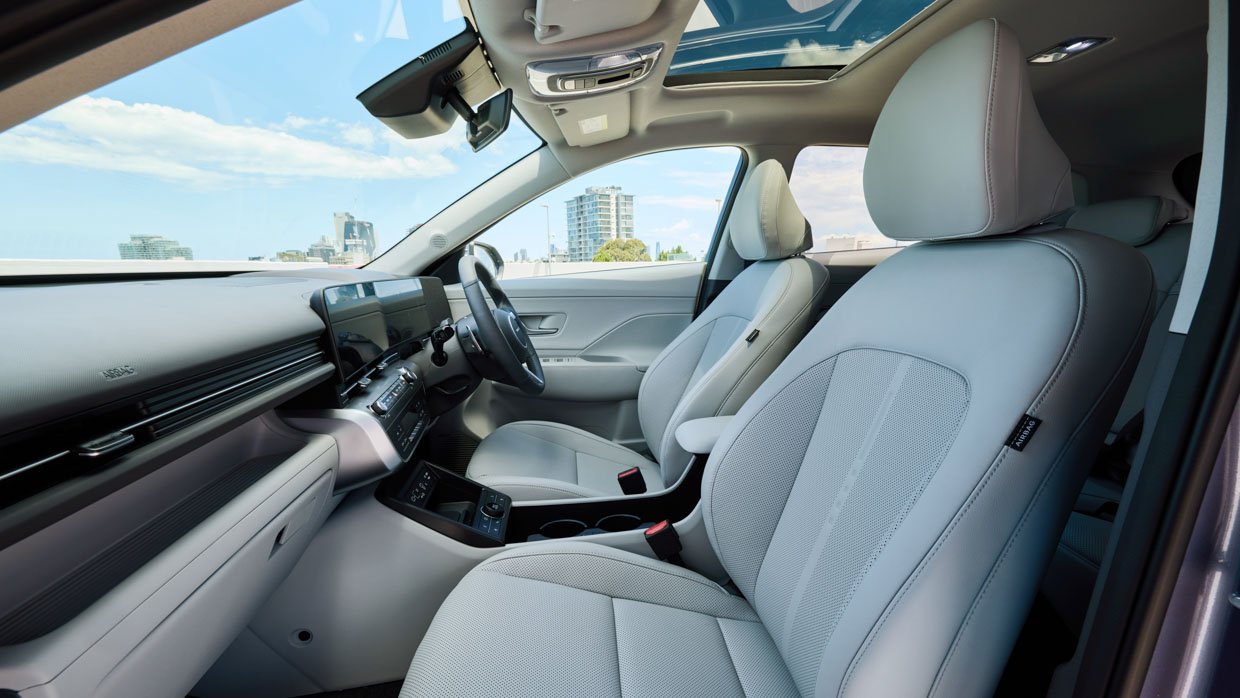
Storage is quite good and given you have a column-mounted gear selector there’s also lots of space in the centre console which has fold-away cup-holders. A decent glovebox is also joined by a flat and open ledge above it where you can rest items too.
In terms of tech, the Kona sports Hyundai’s familiar 12.3-inch dual screens, which feature Hyundai Bluelink connected car services with over the air update capability.
As with the Hybrid, these are effective screens with clean graphics for both the instrument dials and the reasonably intuitive and easy to use media display.
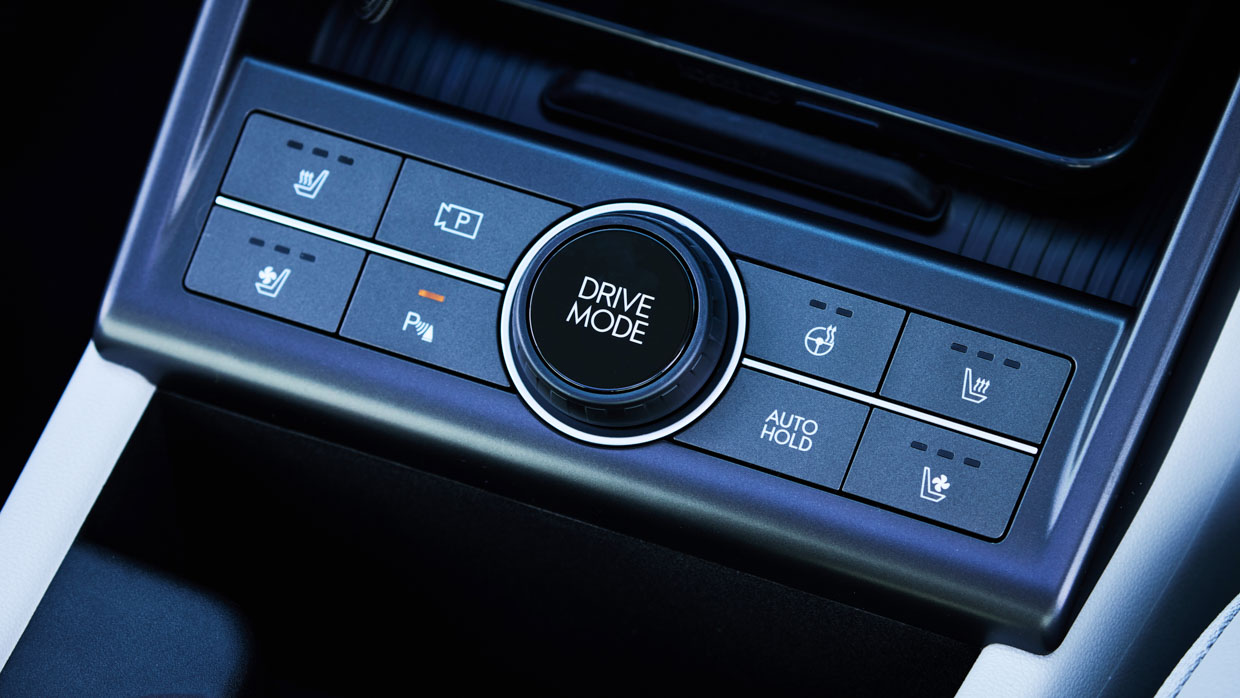
It’s appreciated that Hyundai has maintained physical buttons for things like menu shortcuts, volume, and climate controls, too. Hopefully this will continue in future, as opposed to burying all functions behind a touchscreen.
The fact the Kona was designed as an EV first means that there are no compromises over its non-EV siblings when it comes to the rear seat space – it’s just as roomy as both petrol and hybrid.
At 180cm tall, this reviewer had no issues getting comfortable in the back with sufficient head, leg, and toe room. There’s also a completely flat floor in the Electric which strengthens the usability of the rear seats.
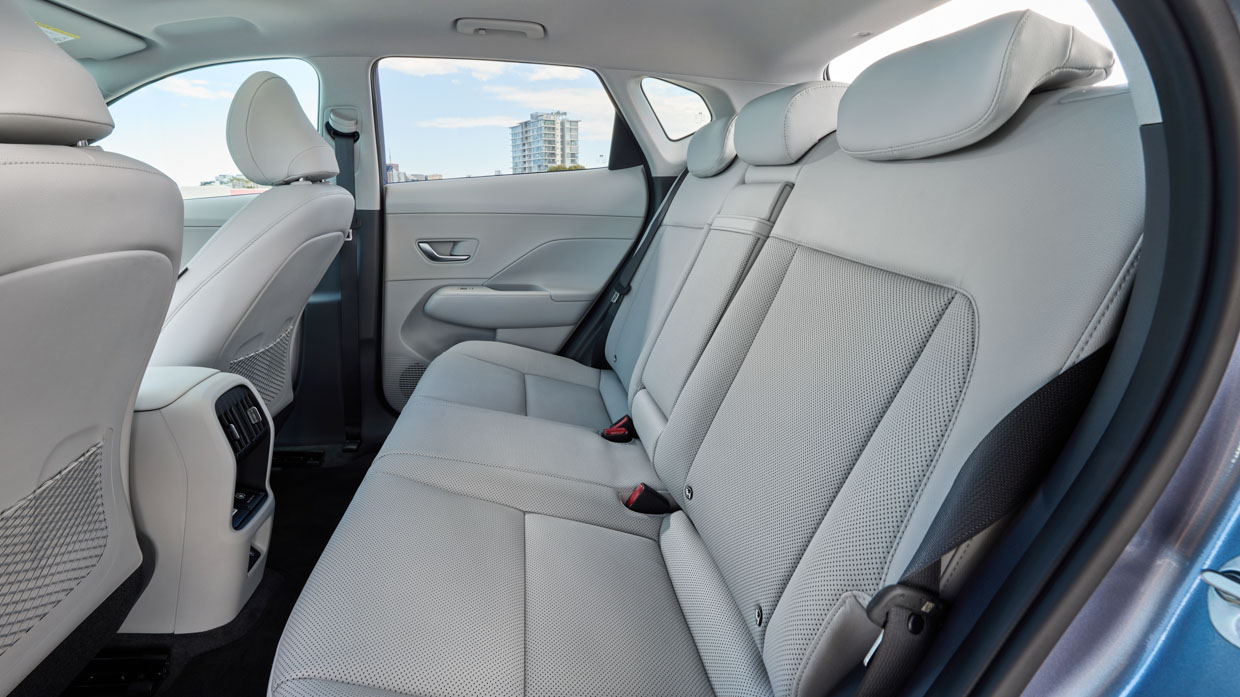
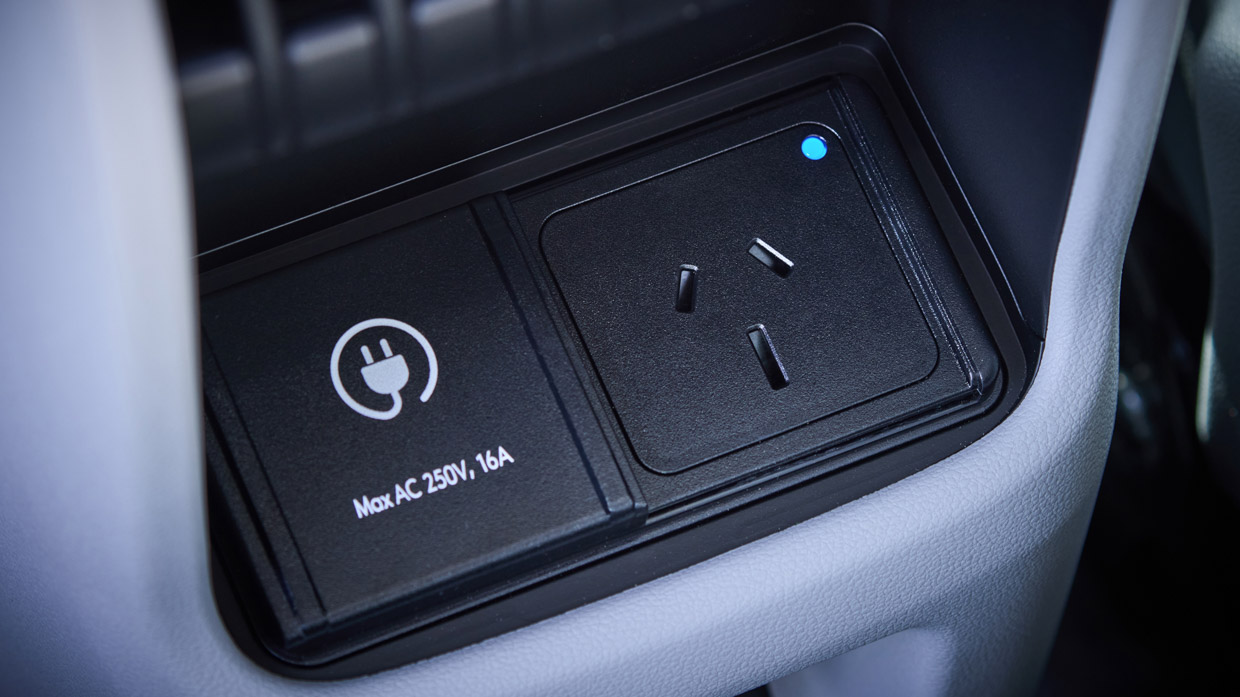
As well as this, there’s also a nice little feature in the fact you can recline the rear seats at slight angles, which adds a nice little bit of variability for long distance journeys.
Visibility in the rear is also quite good and there are decent amenities for passengers with rear air vents, two USB-C connections, a three-pin plug powerpoint, centre armrest, seat pockets, and heated outboard seats for the Premium, which also gains a smart power tailgate over the entry level.
Opening that tailgate reveals a boot which is exactly the same size as the hybrid and petrol Kona, which is commendable for the electric variant. That equates to 407 litres of boot space, which beats the previous generation car by 75-litres.
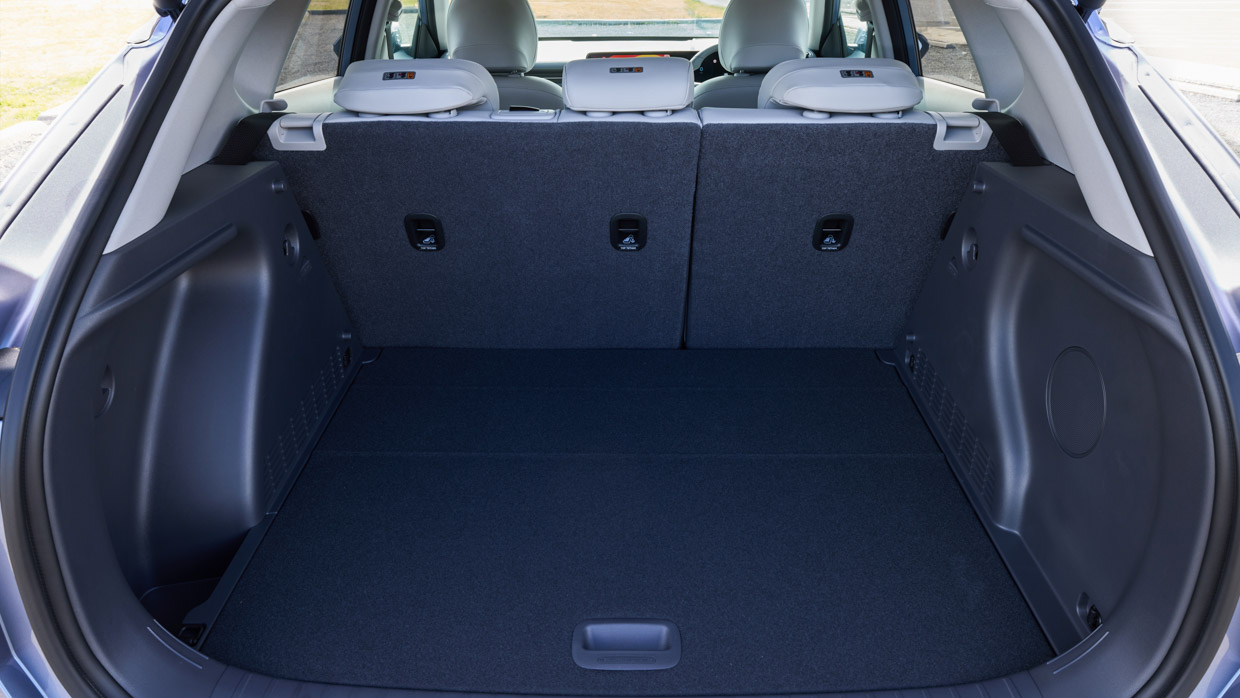
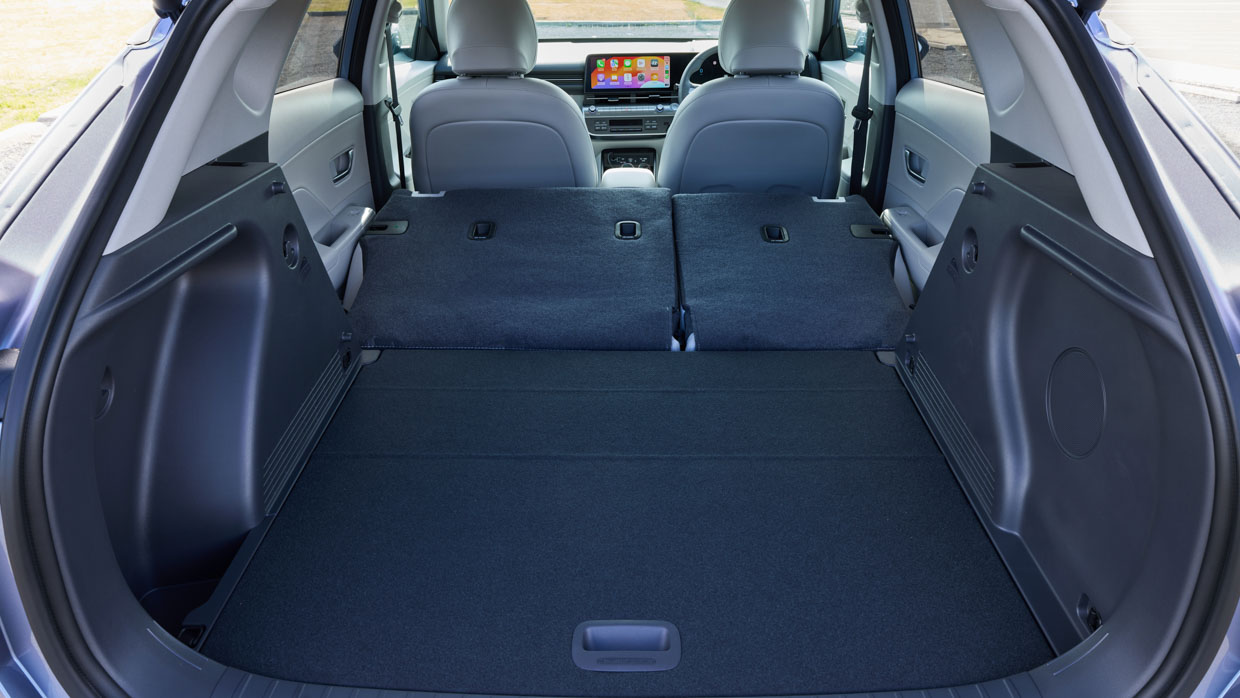
When the rear seats are folded down that bumps up to a claimed 1241 litres up space, an increase of 127 litres on the previous-generation electric.
The boot features a number of amenities including bag hooks, a cargo shelf, luggage floorboard, luggage net, and most importantly – a space saver spare wheel. In an electric small SUV? This reviewer applauds and salutes Hyundai for offering that instead of some tyre repair glue!
And there is another surprise to follow at the front. The EV variant not only features the same boot space as the non-EVs in the back, but also gains an additional 27 litres of storage space under the bonnet, which is space enough for charging cables or perhaps a backpack. That ‘frunk’ comes with an LED light, net, and a sealed lid to protect the compartment.
In terms of safety tech, the new Kona Electric comes standard with the following safety features:
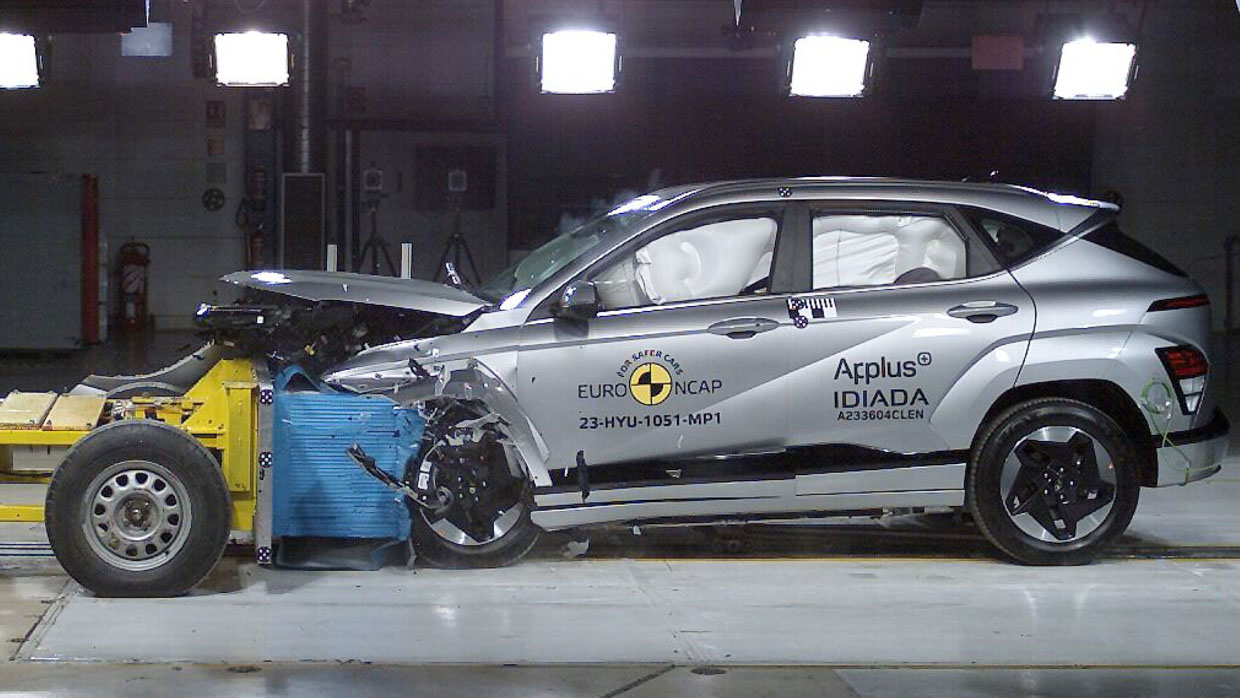
In the Premium, owners gain additional safety features including:
The new Kona range has received a four-star rating by ANCAP, mirroring the four-star result awarded by Euro NCAP earlier this year.
The model scored 80 percent for adult protection and 84 percent for child protection, with 64 percent for vulnerable road user and 62 percent for safety assist. According to ANCAP, it’s the latter two measures dipping below 70-percent thresholds (necessary for a five-star rating) that contributed primarily to the four-star result.
Service internals for the Kona Electric are every two years or every 30,000 kilometres. Overall, that will set you back $1560 over six years, with each service costing $520.
Those service intervals are double that of the hybrid and petrol which are yearly, or every 15,000 kilometres. Meanwhile, the turbo N-Line is also yearly, or every 10,000 kilometres.
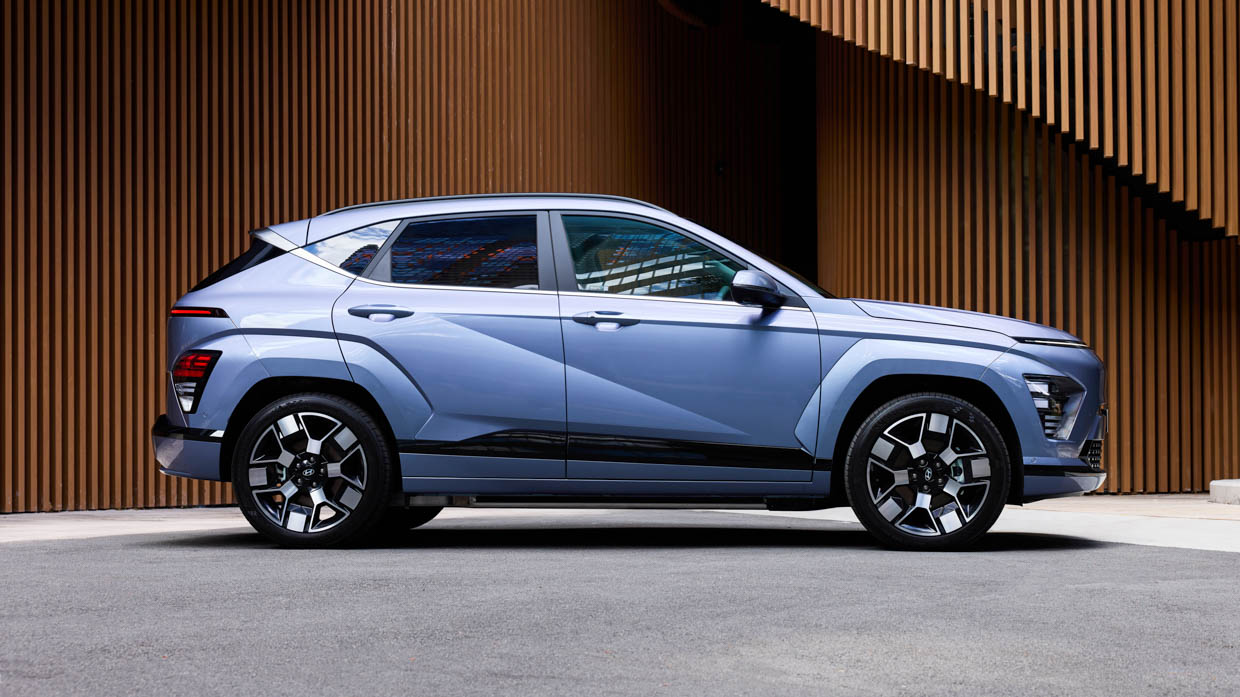
All petrol and hybrid services cost $399, so equating these over six years sees the electric comes in about $800 cheaper.
In terms of warranty, the Kona Electric is covered by Hyundai’s five-year, unlimited-kilometre warranty, with the battery covered by an eight-year, 160,000km warranty.
Our first impressions are that the Kona Electric is not just a solid electric car, but a solid car all-round.
It’s matured over its predecessor and delivers an effortless, comfortable and refined driving experience, combined with a spacious interior, funky styling, and zero tailpipe emissions.
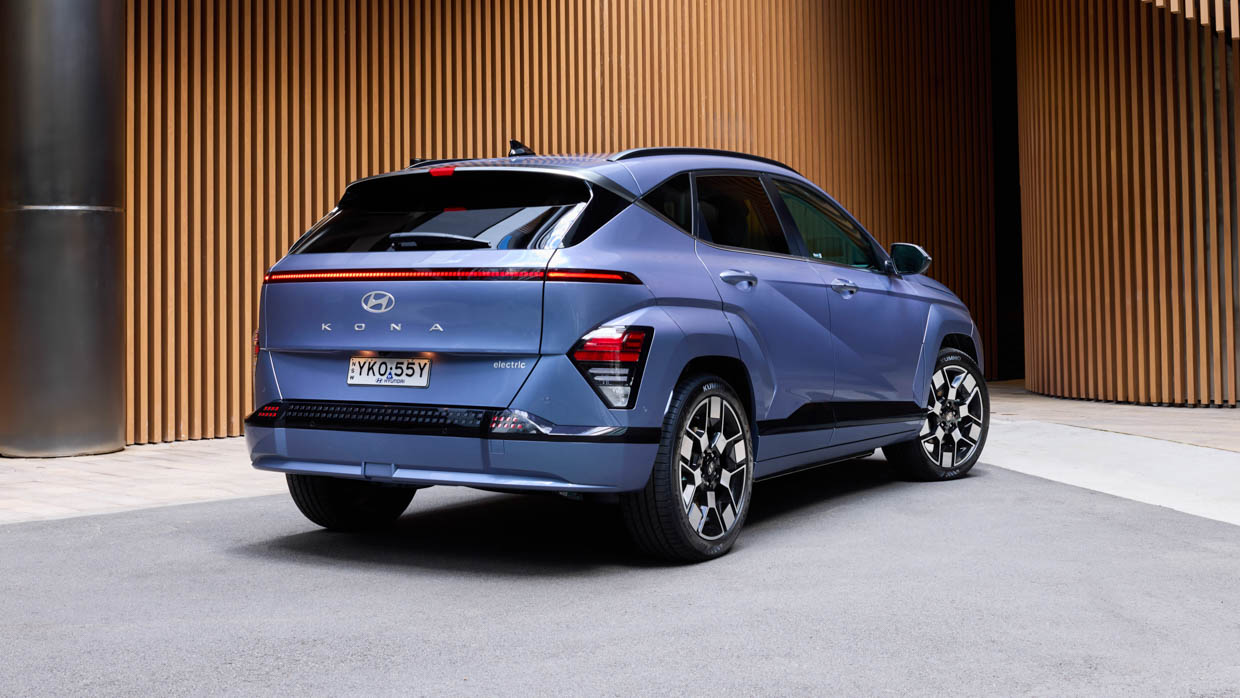
If you are thinking of buying an electric small SUV then it’s definitely a vehicle worth considering. That said, we’d like to spend more time in it to properly test out the claimed range figures and give a more definitive assessment on the vehicle, especially in context of price.
To that point, Hyundai should be commended for maintaining and reducing prices for its entry and mid-spec Kona Electric variants in an age of cut-price Chinese alternatives.
At the top of the range, however, the Kona Electric Premium is starting to push into Tesla Model 3 and Model Y territory, not to mention Ioniq 5 and 6 – all of which sit in a class above.
With a reduced range thanks to its 19-inch wheels, the question remains whether the extended-range entry-level Kona Electric might be the sweet spot in the line-up, if you can live without all of the Premium’s extra fruit….
For now though, while Hyundai may no longer be an entry-level brand, it certainly seems to be earning its stripes to graduate beyond.
About Chasing cars
Chasing Cars reviews are 100% independent.
Because we are powered by Budget Direct Insurance, we don’t receive advertising or sales revenue from car manufacturers.
We’re truly independent – giving you Australia’s best car reviews.
The estimate provided does not take into account your personal circumstances but is intended to give a general indication of the cost of insurance, in order to obtain a complete quote, please visit www.budgetdirect.com.au. Estimate includes 15%^ online discount.
^Conditions Apply
Budget Direct Insurance arranged by Auto & General Services Pty Ltd ACN 003 617 909(AGS) AFSL 241 411, for and on behalf of the insurer, Auto & General Insurance Company Limited(ABN 42 111 586 353, AFSL 285 571).Because we don’t know your financial needs, we can’t advise you if this insurance will suit you. You should consider your needs and the Product Disclosure Statement before making a decision to buy insurance. Terms and conditions apply.
Indicative quote based on assumptions including postcode , 40 year old male with no offences, licence suspensions or claims in the last 5 years, a NCD Rating 1 and no younger drivers listed. White car, driven up to 10,000kms a year, unfinanced, with no modifications, factory options and/or non-standard accessories, private use only and garaged at night.
^Online Discounts Terms & Conditions
1. Discounts apply to the premium paid for a new Budget Direct Gold Comprehensive Car Insurance, Third Party Property Only or Third Party Property, Fire & Theft Insurance policy initiated online on or after 29 March 2017. Discounts do not apply to optional Roadside Assistance.
2. Discounts do not apply to any renewal offer of insurance.
3. Discounts only apply to the insurance portion of the premium. Discounts are applied before government charges, taxes, levies and fees, including instalment processing fees (as applicable). The full extent of discounts may therefore be impacted.
4. We reserve the right to change the offer without notice.